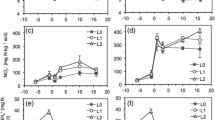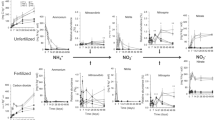Summary
The application of liquid anhydrous NH3 to soil leads to chemical fixation of NH3 by organic matter and of NH sup+inf4 by clay minerals. A laboratory study was conducted to ascertain the biological transformations of newly fixed liquid anhydrous 15NH3 in a Drummer silty clay loam by incubation of the 15N-labelled soil with glucose for 0, 7, 30, and 90 days and by sequential extraction of organic-matter-fixed 15NH3 with 0.15 M Na4P2O7, 0.15 M KOH, 0.1 M NaOH, and acidified dimethyl sulfoxide. About 16% of the 15NH3 injected was fixed, of which 52% was accounted for by clay fixation. The various humic fractions (fulvic acid, humic acid, and humin) were obtained, and the distribution patterns of the fixed 15NH3-N in these fractions were compared. The potential availability of the fixed 15NH3-N was also estimated. The percentage of the 15NH3 recovered as organic-matter-fixed 15NH3 decreased as the length of incubation increased (to 28% after 90 days); the decrease was attributed in part to an increase in the amount recovered as clay-fixed NH sup+inf4 (from 52 to 64%). Changes in the distribution of the organic-matter-fixed 15NH3-N in the humic fractions included: (1) an increase in the relative amount of the fixed 15NH3 as humic acid in both the Na4P2O7 and KOH extracts, (2) an increase in the percentage of organic-matter-fixed 15NH3-N in the fulvic acid fractions as high-molecular-weight components (determined by dialysis) or as generic fulvic acid (determined by sorption-desorption from XAD-8 resin), and (3) an increase in the percentage of the organic-matter-fixed 15NH3 as humin. The potential availability of the organic-matter-fixed 15NH3-N decreased as the length of the incubation increased, from 22 to 4% over the 90-day incubation period, and was correlated significantly (0.05 level) with Na4P2O7-extractable N. These results suggest that organic-matter-fixed liquid anhydrous NH3 is initially more labile than the native soil N but becomes less labile with time.
Similar content being viewed by others
References
Bremner JM (1965) Inorganic forms of nitrogen. In: Black CA (ed) Methods of soil analysis. Am Soc Agron, Monogr 9, vol 2, Madison, Wisconsin, pp 1179–1237
Bremner JM, Mulvaney CS (1982) Nitrogen — total. In: Page AL, Miller RH, Keeney DR (eds) Methods of soil analysis. Am Soc Agron, Monogr 10, vol 2, 2nd edn, Madison, Wisconsin, pp 595–624
Bremner JM, Shaw K (1958) Denitrification in soil. I. Methods of investigation. J Agric Sci 51:22–39
Bureau of Standards (1923) Tables of thermodynamic properties of ammonia. Circular no. 142, US Goverment Printing Office, Washington DC, pp 30–31
Buresh RJ, Austin ER, Craswell ET (1982) Analytical methods in 15N research. Fert Res 3:37–62
Eno CF, Blue WG (1954) The effect of anhydrous ammonia on nitrification and the microbiological population in sandy soils. Soil Sci Soc Am Proc 18:178–181
Eno CF, Blue WG, Good JM Jr (1955) The effect of anhydrous ammonia on nematodes, fungi, bacteria, and nitrification in some Florida soils. Soil Sci Soc Am Proc 19:55–58
Frankenberger WT Jr, Johanson JB (1986) Use of plasmolytic agents and antiseptics in soil enzyme assays. Soil Biol Biochem 18:209–213
Guo P-C, Bohring J, Scherer HW (1983) Vernalten von Dünger-NH4 in Böden unterschiedlicher tonmineralischer Zusammensetzung im Inkubationsversuch. Z Pflanzenernaehr Bodenkd 146:752–759
Hayes MHB (1985) Extraction of humic substances from soil. In: Aiken GR (ed) Humic substances in soil, sediment, and water. Wiley, New York, pp 329–362
He XT, Stevenson FJ, Mulvaney RL, Kelley KR (1988) Incorporation of newly immobilized 15N into more stable organic forms in soil. Soil Biol Biochem 20:75–81
He XT, Mulvaney RL, Stevenson FJ, Vanden Heuvel RM (1990) Characterization of chemically fixed liquid anhydrous ammonia in an Illinois Drummer soil. Soil Sci Soc Am J 54:775–780
Jansson SL, Persson J (1982) Mineralization and immobilization of soil nitrogen. In: Stevenson FJ (ed) Nitrogen in agricultural soils. Am Soc Agron, Monogr 22, Madison, Wisconsin, pp 229–252
Kelley KR, Stevenson FJ (1985) Characterization and extractability of immobilized 15N from the soil microbial biomass. Soil Biol Biochem 17:517–523
Kelley KR, Stevenson FJ (1987) Effects of carbon source on immobilization and chemical distribution of fertilizer nitrogen in soil. Soil Sci Soc Am J 51:946–951
Mulvaney RL, Kurtz LT (1982) A new method for determination of 15N-labeled nitrous oxide. Soil Sci Soc Am J 46:1178–1184
Nömmik H (1981) Fixation and biological availability of ammonium in soil clay minerals. In: Clark FE, Rosswall T (eds) Terrestrial nitrogen cycles. Ecol Bull (Stockh) 33:273–279
Nömmik H, Vahtras K (1982) Retention and fixation of ammonium and ammonia in soil. In: Stevenson FJ (ed) Nitrogen in agricultural soils. Am Soc Agron, Monogr 22, Madison, Wisconsin, pp 123–171
Norman RJ, Kurtz LT, (1986) Laboratory apparatus for preparing and despensing nitrogen-15 labelled anhydrous ammonia. Soil Sci Soc Am J 50:238–242
Norman RJ, Kurtz LT, Stevenson FJ (1987) Distribution and recovery of nitrogen-15-labelled liquid anhydrous ammonia among various fractions. Soil Sci Soc Am J 51:235–241
Parr JF (1969) Retention of anhydrous ammonia by soil. 4: Recovery of microbiological activity and effect of organic amendments. Soil Sci 107:94–104
Russell JD, Vangan D, Jones D, Fraser AR (1983) An IR spectroscopic study of soil humin and its relationship to other soil humic substances and fungal pigments. Geoderma 29:1–12
Stevenson FJ (1982) Humus chemistry: Genesis, composition, reactions. Wiley, New York
Stevenson FJ, Kidder G, Tilo S (1967) Extraction of organic nitrogen and ammonium from soil with hydrofluoric acid. Soil Sci Soc Am Proc 31:71–76
Tomasiewicz DJ, Henry JL (1985) The effect of anhydrous ammonia application on the solubilization of soil organic carbon. Can J Soil Sci 65:737–747
Vanden Heuvel RM (1988) Improved apparatus for preparing nitrogen-15 labelled anhydrous ammonia. Soil Sci Soc Am J 52:1483–1486
Waring SA, Bremner JM (1964) Ammonium production in soil under waterlogged conditions as an index of nitrogen availability. Nature (Lond) 201:951–952
Washer HL, Alexander JD, Ray BW, Beavers AG, Odell RT (1960) Characteristics of soils associated with glacial tills in northeastern Illinois. Ill Agric Exp Stn Bull 665:48–57
Author information
Authors and Affiliations
Rights and permissions
About this article
Cite this article
He, X.T., Mulvaney, R.L. & Stevenson, F.J. Transformations of chemically fixed liquid anhydrous ammonia by soil microorganisms. Biol Fertil Soils 11, 145–150 (1991). https://doi.org/10.1007/BF00336380
Received:
Issue Date:
DOI: https://doi.org/10.1007/BF00336380




